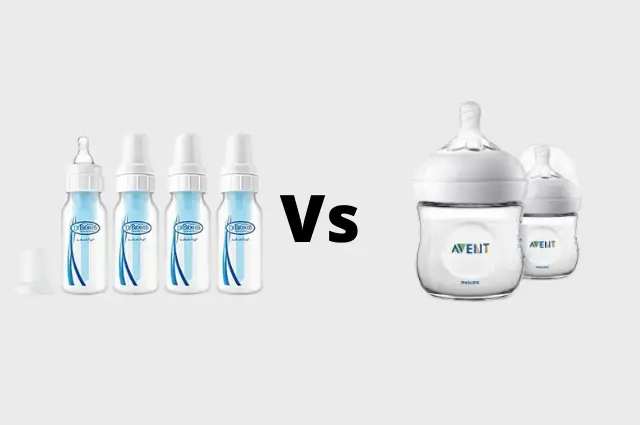All mothers want the best product for their baby, but what happens when the product you thought was ideal for your baby turns out to be the opposite? Deciding on the ideal baby bottle for your baby entails putting a lot of factors into consideration. Some of these factors are teat flow, whether the bottle is anti-colic or not. These factors often put mothers at the crossroads of deciding between Dr. Brown’s bottle vs Avent Bottle.
Hey! By the way… any links on this page that lead to products on Amazon are affiliate links and I earn a commission if you make a purchase. Thanks in advance – I really appreciate it! .
The two bottles were designed to prevent gas intake while eating (This is the primary cause of colic/reflux in babies). Despite the fact they have the same functions, they still have disparities that should be considered. Below is the comparison between Dr. Brown’s bottle vs. Avent bottle.
-
- Dr. Brown’s Bottles
- Philips Avent Bottles
- Major Differences between Dr. Brown’s bottle Vs. Philip Avent bottle
- Commonly Asked Questions About Avent and Dr. Brown’s Bottles
- Can Avent Nipples be Used on Dr. Brown’s Bottles?
- Can Avent Natural Teat be Used on Avent Classic Bottles?
- Can I Wash Dr. Brown’s Bottles with a Dishwasher?
- Can you use Dr. Brown bottles without the inserts?
- Can you sterilize Dr. Brown bottles by boiling in water?
- Can you put rice cereal in Dr. Brown’s bottles?
- Can you shake Dr. Brown’s bottles?
- Can I use Dr. Brown bottles in Avent warmer?
- Can Avent bottles be UV sterilized?
- Can Avent bottles be microwaved to sterilize?
- Conclusion
Dr. Brown’s Bottles
Dr. Brown has become a household name that most mothers were conversant with even before having their babies. They get to hear about it from family and friends who have been pregnant and other mothers and expectant mothers who they may not be very close to. Dr. Brown’s bottles are designed with vents for collecting gases (this reduces gas intake by the baby hence preventing spit-up). This unique feature has made these bottles ideal for babies with reflux, colic, and other gas-related problems.
Asides collection of air, the internal venting system ensures that milk flow is not so fast irrespective of the teat used. This allows babies to drink at their own pace.
Dr. Brown’s Features
Accessories: Dr. Brown’s bottles are made of so many accessories like teats, sealer, and a tube for an air-free feeding
Size: Dr. Brown’sbottles come in different sizes so that mothers have the luxury of choosing what they want, depending on their babies’ age. There are two, four, and eight-ounce options.
Pros
- The internal vents within the bottles reduce colic and reflux in babies.
- Dr brown fits perfectly to most breast pumps making it easy to pump directly into the bottles.
- Research has proved that the bottles help retain nutrients and vitamins present in breast milk or formula.
- Dr. Brown’s are pretty affordable when compared to some brands.
- The small discs situated within the bottles protect them from leaking.
Cons
- Cleaning of the bottles requires disassembling these parts and washing with different sizes of a brush. This process could be a nuisance most mothers would not want to go through.
- The absence of flat bottoms in these bottles has pre-disposed them to the risk of falling continuously as they get empty.
- Failure to insert the discs makes the bottles leak.
Philips Avent Bottles
Philips Avent Bottles is another popular brand that mothers tend to choose from. The brand has designed so many bottles to assist babies in transit from breastfeeding and back again if necessary.
The reason Philip Avent is mostly preferred is the fact they come with fewer accessories than their counterparts. This distinct feature of Philip Avent has made bottle cleaning hassle-free.
Like Dr. Brown’s bottles, Philip Avent reduces colic in some babies and stops air passage while feeding on the bottle. The teats are designed to look like natural nipples, reducing their collapse compared to other similar nipples from other brands.
The teats vary inflow, making it easier to find a new nipple for your Philips Avent Bottle as your baby advances with age, without a need to buy a new bottle altogether.
Also, the Avent brand has a wide range of baby bottles and cups that you could graduate with as your baby gets older.
Philips Avent Features
Accessories: A pack of Philip Avent’s bottle comes with a teat, a screw ring around it, and a cover that prevents spillage.
Sizes: The Philips Avent Bottles are in different sizes. There are four, nine, and 11-ounce bottles.
Pros
- Philip Avent has just a few pieces to clean, making it easier to wash. In cases where there are large quantities to wash, one can even use a dishwasher.
- Philip Avent has various nipples ranging from slower to faster flow, making it easier to swap teats as the baby grows.
- The nipples structure has eased colic and reflux pains for Babies who have such issues.
- When properly capped, Philip Avent can never leak when put in a refrigerator or diaper bag.
Cons
- A slow flow teat may be too fast for some babies.
- The Philips Avent Bottles are costly when compared with Dr. Brown’s.
- The inability of the nipple to go deep enough into the baby’s mouth may result in leaking or spitting out.
Major Differences between Dr. Brown’s bottle Vs. Philip Avent bottle
Although both brands produce anti-colic bottles, many other qualities distinguish the two bottle brands from each other. Some of these differences are:
- Difficulties may be encountered when cleaning Dr. Brown due to the so many parts, whereas Philips Avent bottles are dishwasher safe and are easier to wash.
- Dr. Brown is quite affordable when compared to Philips Avent bottles.
- Research has shown that Dr. Brown’s bottles work efficiently for reflux, whereas Philips Avent bottles relieve reflux to an extent.
Commonly Asked Questions About Avent and Dr. Brown’s Bottles
Can Avent Nipples be Used on Dr. Brown’s Bottles?
Avent nipples cannot be used on Dr. Brown’s because of the specially designed anti-colic system, which includes the long tube and filter top.
Can Avent Natural Teat be Used on Avent Classic Bottles?
Both teats can be used interchangeably on each bottle as long as the Avent screws are used.
Can I Wash Dr. Brown’s Bottles with a Dishwasher?
Dr. Brown’s bottles can be washed with a dishwasher, but because they possess little accessories, it is advised you wash them with Dr brown’s bottle brush to avoid missing out on some parts.
Can you use Dr. Brown bottles without the inserts?
Yes, you can use Dr. Brown bottles without the inserts. However, the inserts help your baby to feed at their own pace conveniently.
Can you sterilize Dr. Brown bottles by boiling in water?
Yes, you can sterilize Dr. Brown’s bottles by boiling them in water. Get a pot and fill it up with water that covers all the parts of the bottle. However, ensure that the bottle doesn’t touch the exposed area of the pot. Boil the bottle for about five (5) minutes. Bring down the pot and allow the water to cool down before removing the bottle. Air-dry the bottle and its parts.
Can you put rice cereal in Dr. Brown’s bottles?
Yes, you can put rice cereal in Dr. Brown’s bottles if you use the options bottles versus the older natural bottles. Of course, you will need to remove the vents when adding the rice cereal. With this, the bottle will not leak. There is another method you can use. Get the Y nipples from Amazon for Dr. Brown bottles. It works perfectly.
Can you shake Dr. Brown’s bottles?
How do you mix your formula in Dr. Brown bottles if you can’t shake it? If you shake the bottle, it leaks and generates bubbles which can cause gas for your baby. You can mix the formula by using the little white disk that came with the bottle or you can stir it gently. Also, you can use Dr. Brown’s formula mixing pitcher available on Amazon. You can store the formula in it and put it in the fridge for 24 hours.
Can I use Dr. Brown bottles in Avent warmer?
Yes, you can use Dr. Brown bottles in the Avent warmer. The regular size and the wide neck size works better with Avent warmer. All you need to do is to adjust the bottom of the basket based on the size of the bottle.
Can Avent bottles be UV sterilized?
Yes, Avent bottles can be UV sterilized. In fact, it is well worth it. It is hygienic since you won’t be using water. It is also hassle-free.
Can Avent bottles be microwaved to sterilize?
Yes, Avent bottles can be microwaved to sterilize. In fact, there is the Phillips Avent Microwave steam sterilizer that is fast and effective at sterilizing Avent bottles. You can put about 4 bottles at the same time.
Conclusion
Bottles are one of the major feeding equipment for babies, and getting the best is important because it is necessary that babies feel comfortable using them. Secondly, quality bottles last longer and do not need regular change. Dr. Brown’s bottle vs. Avent bottle seems to be the best in the market that meets the conditions of comfort and quality. For this reason, many mothers are opting for these bottles.
However, both have their differences which leave some people with the problem of deciding which is better. This article analyses the features, pros, and cons of each bottle to help mothers decide easily which of the two bottles to buy.




